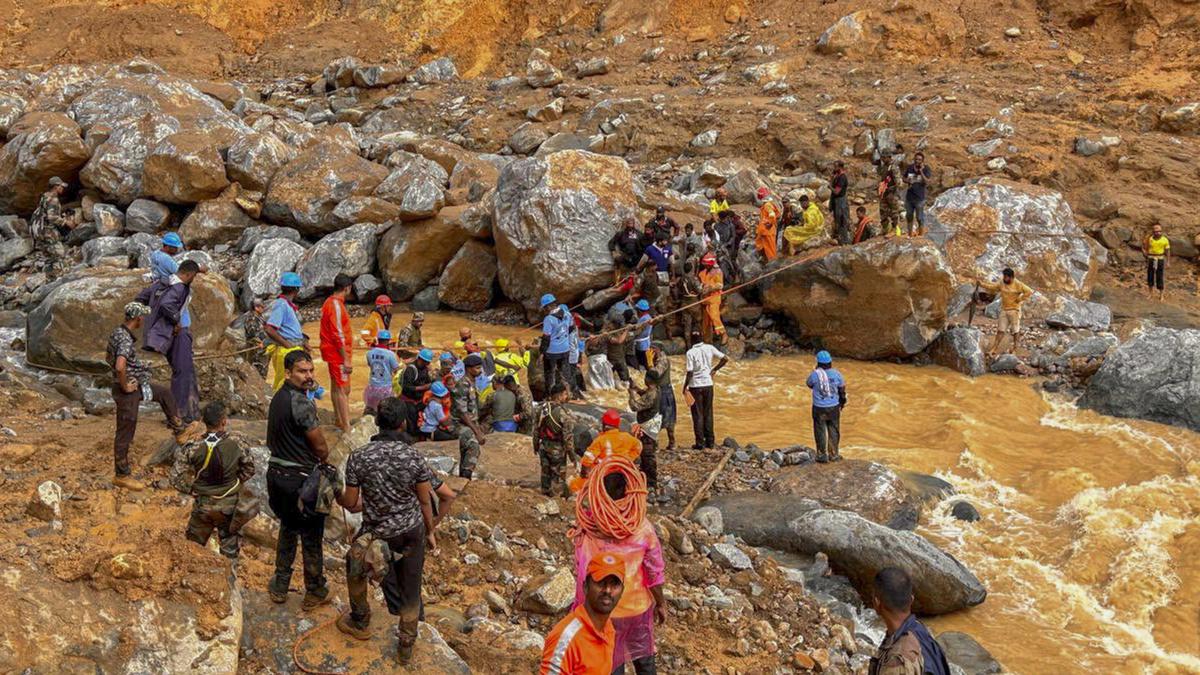Army personnel carry out rescue operations on the second day after landslides triggered by heavy rain at Chooralmala, in Wayanad district, July 31, 2024.
| Photo Credit: PTI
The Hindu’s fact check of Union home minister Amit Shah’s claims on the floor of Parliament found Kerala may not have had much inkling that landslides as devastating as those in Wayanad on July 31 were going to occur, at least based on the content of forecasts the India Meteorological Department (IMD) and Agromet issued.
But recall an important lesson the COVID-19 pandemic taught us: a new virus in a population will lead to more morbidity and mortality if the population is unhealthier. If more people fall ill, it doesn’t necessarily mean the virus has become stronger: we will have to eliminate the confounding factor of population health first. In the same way, a “small landslide” of the kind the forecasts asked Kerala to expect could still have led to the loss of hundreds of lives and infrastructure worth crores of rupees because over many years people have set up shop in a dangerous place — and in many cases successive State governments have simply let them.
In fact, this has been an important lesson of climate change as well: if something goes wrong and anomalous weather is found to have had a part, a political narrative often emerges to demand the weather shoulder all the blame. Yet the travails of anomalous weather will sooner impose on thatched roofs than brick-and-cement ones, for example, because what ’travail’ or ‘devastation’ looks like depends on communities’ and infrastructure’s ability to resist abrupt changes to their material conditions.
Our governments are responsible for inculcating this resilience, and the Wayanad landslides are an acute symptom of Kerala’s shortage of it. The claim that Kerala had sufficient early warning of a deadly landslide in Wayanad, as Amit Shah staked in Parliament, may have been false. Yet the fact remains that if there hadn’t been villages, hotels, homestays, roads, railway tracks, etc. in the path of the Chaliyar river — whose fury destabilised the land — questions of the landslides’ “bigness” or “smallness” may not be as important as they are today.
Simply speaking, successive governments in the State have been neglecting the same actions for some time now. Ecologist and Western Ghats Ecology Expert Panel (WGEEP) chairman Madhav Gadgil told The Hindu “the disaster in Wayanad [was] a man-made tragedy” and attributed it to “the Kerala government’s failure to implement crucial ecological recommendations”. He also “criticised the State government for not adhering to the panel’s guidelines designed to prevent such disasters amid extreme climate changes”.
The Kasturirangan Commission followed by diluting the WGEEP’s recommendations, especially its estimate of the prevalence of ‘ecologically sensitive areas’: from 64% of the Western Ghats to 37%.
The Kerala government had rejected the WGEEP’s recommendations a decade ago over Wayanad’s longstanding population of agricultural workers, whom the State couldn’t readily move away. In fact, climate change expanding zones of threat to new areas warrants a State-level mechanism to plan and control the migration of people to and settlements in different parts of Kerala — including internally and based on the needs of specific communities, e.g. tribals. The State also has a dense population distribution, meaning poor planning quickly places a large number of people in harm’s way. A people-cum-place mechanism may be the need of the hour.
In parallel, the infrastructure development for tourism, resource extraction, renewable energy projects, etc. are more recent as are the particularly deadly landslides. Even if their coincidence in time may be just that, a coincidence, Kerala needs to evaluate links between the two and act on its findings.
This conundrum has another important piece: whether the models based on which the IMD and its subscribers learn about potential impending disasters like landslides and floods account for infrastructure development at specific sites or, importantly, whether they account for previous natural events in the same place. For example, as The Hindu’s editorial on August 1 wrote, “heavy rains … in 2020 had caused the Chaliyar to strip swaths of its upstream areas of plant cover, leaving more rocks and humus vulnerable to being displaced”. The river brought these rocks and sediment tumbling down this year, rendering the resulting flood and landslide deadlier than they might have been without the heavy rains in 2020. Did the models account for this local quirk? Because they should.
This said, a follow-up question: would it matter for Kerala’s sake if the models hadn’t accommodated the effects of the 2020 rains?
Arguably, the answer is ‘no’.
Kerala desperately needs to bolster its ability to resist shocks. While Amit Shah was wrong, fixating on his claims and the subsequent counterclaims could distract us into thinking the early warning Kerala did or didn’t receive last week could have ameliorated the devastation. Perhaps it could have; perhaps local authorities could have been mobilised to relocate people to safer ground. But these warnings can be hit-or-miss given the vagaries of hyperlocal conditions and by virtue of being piecemeal in the face of threats that simultaneously endanger people and places.

